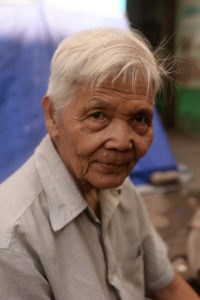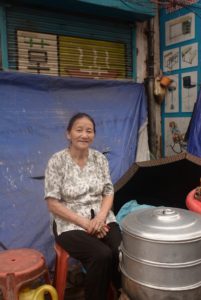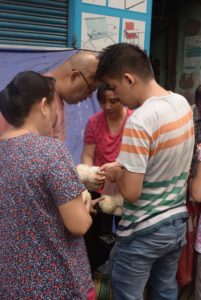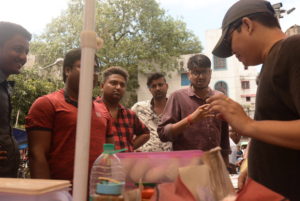By Isobel Chiang, 07/30/2019. Tucked precariously inside Kolkata’s Bowbazar district is Territy Bazaar, known colloquially as “Old Chinatown.” I say “precariously” because if you didn’t know better, you could easily miss it: unlike established Chinatowns in San Francisco or New York, there are no external markers to let you know you’ve crossed into a new social and cultural space — no red awnings, no lanterns hanging from lamp posts, no dragon iconography.
Instead, Territy exists humbly within one of Kolkata’s busiest neighborhoods, as if it doesn’t want to make too much of a fuss. Where it was once a vibrant area, it has been reduced to a handful of Chinese restaurants and five Chinese temples.
The only time that you can really “see” Kolkata’s Chinatown — that is, when it makes its presence known — is on Saturday and Sunday, during the infamous Cheenapara Breakfast (Cheena means “people from China,” and para is a Bengali term for neighborhood). From 6 am to 9:30 am (or whenever the food sells out), it feels as if the inner life of Chinese Indians literally spills out onto the street.
I arrived at around 6:45 am. None of the surrounding Muslim restaurants were open. The sidewalk fruit-sellers were just beginning to set up shop. Even the usual cacophony of car honking — the soundtrack of India — was momentarily hushed. Kolkata was just beginning to open its eyes.
And yet, Cheenapara breakfast was in full swing. There were a handful of vendors along the sidewalk, set up with portable plastic tables and tiered aluminium vessels (picture an oversized, steaming tiffin) filled with items such as fish and chicken momos, steamed pork paos, wontons (either steamed or fried), chicken spring rolls, sweet sesame balls, fish ball soup, and sticky rice wrapped in banana leaves. About half of these vendors were Chinese Indians, while the other half were Bengalis. The crowd was equally as mixed: the majority of the customers were Indians, but I did see a lot of Chinese families enjoying their breakfasts as well.
The breakfast vendors were joined by vegetable, chicken, and fish sellers (all of whom were Indian). There was even a man making chai.
It became clear to me that the market serves a perfunctory role: many people came and went in a few minutes — they were there just to pick up their groceries and a few breakfast items, engaging with the market in a strictly commercial way. But after a few hours of talking to vendors and quietly witnessing the flow of the market, I noticed that it serves a deeper function as well. Firstly, it’s a place where Chinese Indian people gather and hang out: I observed a cluster of elderly women sitting and talking in a circle, and over the course of the morning, the cluster grew and grew. I saw several Chinese Indian families stop in the street to say hello other families they recognized. Secondly, the market is a vital way for the Chinese Indian community to remain visible to the broader Indian majority, as if to advertise and assert that, yes, we are still here. Thirdly, and perhaps most importantly, the Cheenapara breakfast is a social space where Bengali and Chinese cultures can overlap and mingle. “My friends and I come here for breakfast because we know that the Chinese have been in Kolkata for hundreds of years,” said one Bengali customer. “We know the food will be good.”
My favourite part of the morning was witnessing Mrs. Lui, a Chinese Indian from Tangra (Kolkata’s second Chinatown). She comes only on Sundays, I was told, and you have to order from her a week in advance. With several messenger bags full of homemade provisions, Mrs. Lui rode in on her scooter at around 7:30 am, when the market was at its busiest. A crowd of people immediately swarmed around her, “lining up” in what I’ve observed is a typical Indian queue — a triangle, where the pointy edge faces away from whatever is being sold.
Inside her bags were homemade pork and chicken pao buns, blocks of silky tofu, and a variety of other things I can neither spell nor pronounce. Whatever pre-ordered food is not claimed, she sells on the spot. I was lucky enough to grab the last pork pao, which was was fluffy and light, like savoury cotton candy.




